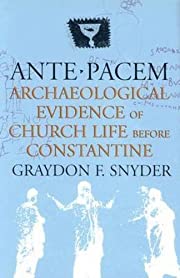
Arthur Droge has made available on his academia.edu page an article in which he presents
- a strong case for that “rulers of this age … crucified the Lord of Glory” passage in 1 Corinthians not being part of the original letter
- reasons to think the passage was added to the letter around 140 CE
- evidence for a wide variety of early Christian views about the crucifixion (some had it on earth, some in the firmament, with and without suffering…)
- implications of the above that point to Paul’s letters evolving through various hands over time and no more being penned by “Paul” than any of the surviving letters, acts, gospels and apocalypses bearing the names of Peter, James, John, Thomas, Barnabas, Mark, Matthew, Luke, etc were genuinely penned by those figures.
The article is Whodunnit? Paul’s Peculiar Passion and Its Implications. The link is to the article on academia.edu.
I will certainly have to write out the key points of Droge’s article and add it to my archived series “Rulers of this Age” in 1 Cor. 2:6-8 but till then I leave the above link for interested readers to check out the full 22-page article for themselves.
Some interesting excerpts.
What is an Interpolation?
By interpolation I simply mean a retrospective change in an older text, usually introduced with the intention of “clarifying” or “improving” it, or bringing out what was thought to be its “real” meaning. The change may have taken place when a work was copied and perhaps re-edited at some point after its original composition. That is to say, interpolations are an all-too-common feature of texts that have come down through a succession of manuscripts or handwritten copies. While the identification of interpolations is unremarkable in other disciplines, whose canons likewise derive from manuscripts, it is looked down upon by New Testament scholars. (p. 6)
Indeed. See, for example, a list of 30 ancient texts cited to justify the term “a culture of interpolations” see A Case for Interpolation Does NOT Rely On Manuscript Evidence. See also my 2009 post Forgery in the Ancient World for another list of mostly classical texts. Recall, further, most recently Greg Doudna’s proposal that the John the Baptist passage in Josephus is a “misplaced” passage — another type of “interpolation”.
Droge offers two criteria for identifying interpolations:
- significant differences in language, style, and subject matter.
- the removal of the suspect passage has to make the resultant rejoining of the surrounding material more cogent, smoother….
On the basis of those criteria Droge demonstrates a very strong likelihood of the “rulers of this age” being an interpolation.
No consensus in early Christian texts about who crucified Jesus, or about when, where, how, or why
For even a casual sampling of texts from the Christian archive makes it patently clear that there was no consensus about who crucified Jesus, or about when, where, how, or why Jesus was crucified. Indeed, as we shall see, there was not even a consensus about whether Jesus was crucified. Each of these questions was a point of conflict and contestation for centuries before the Christians finally managed to get their story (more or less) straight. (p. 12)

I confess I was somewhat thrilled to see Droge make the use of some of the same archaeological evidence that has influenced my own thinking: the crucifixion of Jesus was not the primary focus of early Christian belief if one turns to early sarcophagi and catacomb art. Jesus is more likely to be depicted as a youth, a good shepherd, a healer than crucified. Droge adds the significant point:
The silence of the archaeological record in this case is a stark warning about extrapolating from texts ideas widely shared by the rank and file, or by the socalled “communities” supposedly lurking behind the texts we read and to which they provide access. (p. 12)
Droge directs readers to Stowers and Rüpke. I’ll quote a little from each:
The pervasive assumption that all Christian literature and history in the first one hundred years or so sprang from and mirrored communities inhibits historical explanation by social and psychological theory that is normal for the rest of the academy. A community in this sense is a highly coherent social formation with commonality in thought and practice. The idea that the Christian movement began with these communities derives from Christianity’s own myth of origins, but has been taken as historical reality. The myth can be traced to Paul, Acts and Eusebius. (Stowers, 238)
and
If the authentic letters [of Paul] (which might themselves be the result of later redactional combinations) are seen as an example of the formation of a network among like-minded persons in Jewish diaspora communities in Asia Minor and the Greek mainland, we could expect hundreds of letters – and we cannot exclude that they were in existence. The published corpus, however, is characterised not by the documentation of a network, but by a pseudepigraphical supplementation, which partially even theologically reflected on pseudepigraphy. The different agents of this continuation had heterogeneous interests. They were engaged in the prolongation of Paul and contested others’ interpretations; they venerated and instrumentalised Paul. These conflicting views were certainly connected to the interest in and critique of the specific Pauline practices and beliefs which we find even more prominently outside of the corpus, in Lukan Acts for instance. All this indicates that we are not dealing with archives of communities and local identities, but with professional exegesis and philosophical schools (and with Marcion, even historical research). (Rüpke, 180)
Now that makes a lot of sense when we recall Justin Martyr’s identification of himself as a philosopher and recall Abraham Malherbe’s demonstrations that the Pauline writings suggest we are closer to the mark when we compare early Christian thought and propagation with the philosophical schools of the day than with “mystery cults”.
Droge brings the Ascension of Isaiah into the discussion and reaffirms the view that the section on the birth, miracles and crucifixion of Jesus is a later addition and that the original text depicted a crucifixion in the Firmament. We recall Earl Doherty’s and Richard Carrier’s works. I have lately gone a bit back and forth on that question so I am willing to resume a back seat for a while and watch and learn with more reading and reflection. A significant difference, however, is that Doge insists on the Ascension of Isaiah being a post-Pauline second-century work whereas Doherty was prepared to lean towards those who dated it as early as the late first century. Droge’s point is that an Ascension of Isaiah scenario of Rulers of this Age crucifying Jesus points to the Pauline passage being added in the second century.
The idea that Jesus did not actually die on the cross is traced from a very literal reading of the Gospel of Mark (it was Simon of Cyrene who was crucified), the related view of Basilides in the second century, through the Second Treatise of the Great Seth and Apocalypse of Peter. Ignatius and Justin further indirectly hint at this rival belief. The spiritual dimension of the event is presumably a reaction to a narrative set in the mundane realm.
But if that’s the case, why? We don’t normally expect sectarian branches to rewrite a historical tradition as having happened in the heavens. But it does make sense if that mundane narrative involving Galilee, Pilate, a lynch mob of Jews, etc. was built from a “midrashic” reading of Hebrew Scriptures. If so, there was room for others to disagree and propose other interpretations of those scriptures. Hence I found most intriguing Droge’s pointing out the way gnostic myths were derived from particular readings of Psalms. Psalm 2 has God laughing at rulers thinking they can defy God and his anointed. Enter the gnostic accounts of Jesus laughing at those who are thinking they are crucifying him on the cross. Similarly for the myth of descent and ascent through the heavens: Psalm 24 speaks of the King of Glory which is close to the Ascension’s Lord of Glory, and it also speaks of him progressing through “gates”.
But why?
Why were those verses about spirit beings crucifying Christ added? Best for you to read Droge’s article. Meanwhile, no, Droge does not suggest they were polemical or deviously attempting to undermine the original views of Paul. He sees the addition of the passage more as a commentary.
The more interesting and important consequence is the recognition that our passage was a second-century gnostic attempt to ventriloquize Paul, to make him say what he should have said – indeed, must have said – and to do so in a fashion not dissimilar to the way in which the modern guild of scholars continues to carry on the time-honored task of Pauline commentary.
Claude Lévi-Strauss is worth recalling at this point:
[A] myth is made up of all its variants, [therefore] structural analysis should take all of them into account. . . . . There is no one true version of which all the others are but copies or distortions. Every version belongs to the myth. (pp 435f)
Commentaries as expansions and explanations become another version of the myth. Droge points the finger at the Valentinian scholars of the second century,
for whom Paul’s letters were a major focus of their commentarial endeavors, and who succeeded in creating a Paul in their own image, and then esteemed him as the chief architect of their mythmaking. Our passage is one, very small, but precious, piece of that enterprise, which has managed, purely by chance, to survive as a page in the archive or dossier that only later would be called “First Corinthians.”
How the sausage is made
So how did the letter-making sausage machine work, according to Droge?
By recognizing that our passage is an interpolation of the second century, we can see that individual letters were still under construction well into that century, and we can begin to discern some of the ways in which that building process worked. Already at a pre-collection stage, Paul’s “letters” were far from static or inert data, moving through time under the guardianship of vigilant Christian scribes. Rather, the materials out of which individual letters would be constituted were still in flux, and provided occasions for innovative and improvisational interventions from a variety of sources, with a variety of interests, and in a variety of forms (e.g., emendations, deletions, glosses, interpolations, commentary, short narratives, and so on). As I have tried to suggest, it would be better to think of “First Corinthians” at the pre-collection stage as an active site or open file, more along the lines of an archive or dossier, and certainly not a unified, much less actual, letter. So conceived, the process that yielded the letter known as “First Corinthinas,” as well as the collection known as the corpus paulinum, would be analogous to the process of the composition of the gospels. In other words, at some point in the second century materials of heterogeneous origin, date, and provenance began to be fashioned into a loose epistolary form and attributed to a figure from the first century. (21f)
Droge, Arthur. “‘Whodunnit? Paul’s Peculiar Passion and Its Implications.’” Accessed May 10, 2021. https://www.academia.edu/43327375/_Whodunnit_Paul_s_Peculiar_Passion_and_Its_Implications_.
Lévi-Strauss, Claude. “The Structural Study of Myth.” The Journal of American Folklore 68, no. 270 (1955): 428–44. https://doi.org/10.2307/536768.
Rüpke, Jörg. “The Role of Texts in Processes of Religious Grouping during the Principate.” Religion in the Roman Empire 2, no. 2 (2016): 170. https://doi.org/10.1628/219944616X14655421286059.
Stowers, Stanley. “The Concept of ‘Community’ and the History of Early Christianity.” Method & Theory in the Study of Religion 23, no. 3 (2011): 238–56. https://doi.org/10.1163/157006811X608377.
